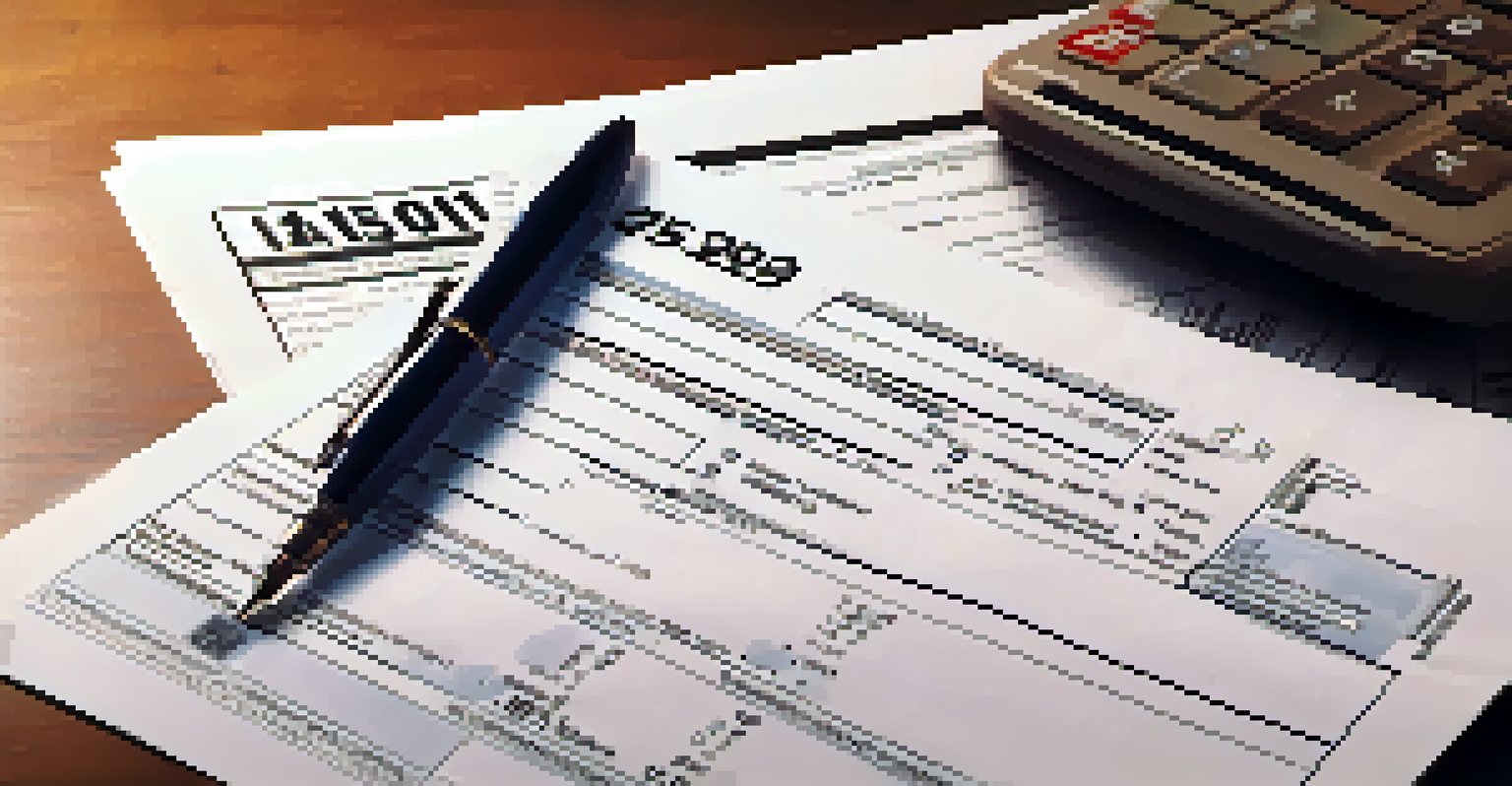Adjusting Your Tax Withholding: A Step-by-Step Guide

Understanding Tax Withholding: The Basics
Tax withholding is the amount of money your employer takes from your paycheck to cover your estimated annual tax bill. This process helps ensure that you don’t owe a large sum when tax season rolls around. Essentially, it's like prepaying your taxes throughout the year, which can ease the financial burden come April.
In this world, nothing can be said to be certain, except death and taxes.
The goal of withholding is to match your tax payments to what you owe as closely as possible. If too much is withheld, you might receive a refund, but if too little is withheld, you could face a tax bill and possibly penalties. Understanding how this process works is the first step in adjusting your withholding accurately.
To adjust your withholding, you'll need to evaluate your financial situation, including any expected changes in income, deductions, or credits. A clear grasp of these factors will set the stage for making informed decisions about your withholding.
When to Consider Adjusting Your Withholding
There are several life events and financial changes that can signal it's time to adjust your tax withholding. For instance, getting married, having a child, or starting a new job may all impact your tax situation. Additionally, changes in income, such as a raise or a decrease in hours, can also necessitate a review.

If you received a large tax refund last year or ended up owing money, those are strong indicators that your withholding might need adjustment. A hefty refund might suggest that you're over-withholding, while owing money could mean you're under-withholding.
Understanding Withholding Basics
Tax withholding is the money taken from your paycheck to prepay your estimated annual tax bill, helping to avoid a large tax burden at the end of the year.
It's also wise to reassess your withholding if you experience significant changes in deductions or credits, like buying a home or incurring medical expenses. By staying proactive, you can help ensure your withholding aligns with your current financial picture.
How to Calculate Your Ideal Withholding
Calculating your ideal tax withholding can seem daunting, but it’s actually quite manageable. Start by estimating your annual income, factoring in all sources of income, such as wages, bonuses, and side gigs. Then, consider potential deductions and credits you might claim, as these will affect your overall tax liability.
The only thing worse than paying taxes is not paying them and getting caught.
The IRS provides a helpful tool called the Tax Withholding Estimator, which simplifies this process. By inputting your information, you can get a clearer picture of how much should be withheld from your paycheck. This resource can be particularly beneficial for those who find tax calculations intimidating.
Once you have an estimate, you can compare it to your current withholding to decide if an adjustment is necessary. Remember, the goal is to get as close as possible to your actual tax liability to avoid owing or getting a refund.
Completing the IRS Form W-4
To adjust your withholding, you'll need to complete the IRS Form W-4, which is straightforward and user-friendly. The form allows you to specify how much you want withheld from each paycheck, based on your calculations. This is your opportunity to communicate your withholding preferences to your employer.
The W-4 form has gone through changes in recent years, so it’s important to review it carefully. It includes sections for personal information, allowances, and additional withholding amounts. Be sure to fill out all relevant sections accurately to ensure your employer can process your request correctly.
Adjust When Life Changes Occur
Life events like marriage or a new job can affect your tax situation, signaling the need to reassess your withholding.
After completing the form, submit it to your payroll department or HR. They will make the necessary adjustments to your paycheck, ensuring your withholding aligns with your new specifications moving forward.
What Happens After Adjusting Your Withholding
Once you submit your updated W-4 form, your employer will adjust your withholding in the next payroll cycle. This means you should start seeing changes in your take-home pay relatively quickly, which can either increase or decrease based on your new withholding amount. It's a good idea to monitor your paychecks for the first few months to ensure everything is accurate.
You may want to review your pay stubs for changes in the federal income tax withholding line, as this will reflect your adjustments. If you notice discrepancies or have concerns, don’t hesitate to reach out to your HR or payroll department for clarification.
Remember, adjusting your withholding isn’t a one-time task. Life circumstances change, and it’s wise to review your withholding periodically, especially after major life events or changes in income. Staying proactive will help you avoid surprises during tax season.
Common Mistakes to Avoid When Adjusting Withholding
When adjusting your withholding, it’s easy to make mistakes that can lead to financial headaches down the line. One common mistake is not accounting for all sources of income, such as freelance work or investments. Failing to include these can lead to under-withholding and a tax bill when you file.
Another pitfall is not updating your withholding after significant life changes. For example, if you get a new job with a higher salary or experience a significant change in family status, your previous withholding may no longer be appropriate. Regularly reviewing your W-4 can help you avoid this issue.
Avoid Common Withholding Mistakes
Key mistakes include not considering all income sources and failing to update withholding after significant life changes, which can lead to unexpected tax bills.
Lastly, many people underestimate their deductions and credits. If you're eligible for various deductions, like student loan interest or mortgage interest, failing to account for these can lead to over-withholding. Take the time to understand your tax situation fully to make informed adjustments.
Seeking Professional Help for Withholding Adjustments
While adjusting your tax withholding can be straightforward, some situations may warrant professional assistance. If you have complex financial circumstances, such as multiple income streams or significant investments, consulting a tax professional can provide clarity. They can help you navigate the intricacies of tax law and ensure you’re making informed decisions.
A tax advisor can also help you understand the implications of your withholding adjustments on your overall tax strategy. They can provide insights into how changes in withholding can affect your tax return and whether you should consider estimated tax payments instead.

If you're uncertain about your calculations or the best approach for your situation, don’t hesitate to reach out for support. Investing in professional guidance can save you time, money, and stress in the long run, making the tax season much smoother.